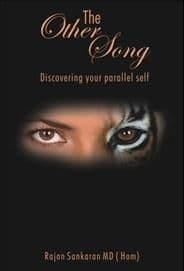What is it that makes each one us who we are ?
What is it that makes each of us feel, perceive, experience and act in our own unique manner?
What is the real cause of the stress in your life?
Renowned homoeopathic physician Dr Rajan Sankaran has been working on these questions in his practice for the last three decades and has made some startling discoveries.
He found that stress comes not from external reality but the specific way each of us perceives it. At the deepest level our experience is not of outer reality, but is a constant inner sensation.
This core sensation matches something from one of the three kingdoms in nature. It is as if a specific animal, plant, or mineral lives in each one of us and colours our whole experience of life. It is our constant companion, the other song that keeps singing within us, shapes our personality, determines our life patterns, and is the underlying factor behind our stress.
Dr Sankaran sets down the knowledge that decades of seeing patients have taught him about the inner other song within each of us in order to guide the reader to awareness of his own other song and find release from it.
- Author: Rajan Sankaran
- ISBN: 9788190337823
- 408 pages
- Paperback
- Published in 2009
- Printed in India
Book Reviews - Homoeopathic Links - Summer 2009, Vol. 22 Page : 117
Reviewed by Jay Yasgur, R Ph., M.Sc. USA
Rajan Sankaran has written so many books that his bibliography has become muddled.
So which volume should the neophyte begin with? Perhaps it is this one. The Other Song, because in four hundred pages he covers it all: The Source of Stress, The Two Songs, The Levels, A Map to the Inner World, Three Postulates, Our Coping Reactions (Mechanisms), Technique of Reaching the Depth, Doorway Through Doodles, Metaphors, Awareness: The Way to Healing and Case Studies, to which he devotes some seventy pages.
It is in A Map to the Inner World’ that Rajan describes the energy or essence of the three kingdoms and the periodic table. It is in this chapter that Rajan proposes that: “...each of us lives two lives simultaneously [this initially appears contradictory], a careful observation of human nature shows it to be true. To quickly recapitulate the earlier observations, one is our life as a human being where energy sings the human song. On delving deeper, we find a completely different world inside which seems to sing the 'Other Song’ altogether, another melody. This other melody is not innately human but is a reflection of a pattern that we have borrowed from nature - be it from a plant, a mineral, or an animal. Therefore, this energy pattern is appropriate to nature, not to us. We have borrowed it to cope with our perception of reality.
The natural world consists of the animal, the plant, and the mineral kingdoms. The energy of each of these kingdoms is very different, as outlined below. As humans, we borrow an energy pattern (from one of these kingdoms) which corresponds to our inner way of perceiving and reacting. Depending on which kingdom is the ‘source’ of the ‘Other Song’ within a given individual, human beings can be mapped into one of these three kingdoms. There is an innate difference in the basic problem issue of persons belonging to each of these three kingdoms.” - p. 92
He summarizes the ‘Other Song’ as found in the three kingdoms as ‘heightened sensitivity’ (plant), ‘survival, competition, and vic- tim/aggressor issues’ (animal), and ‘a feeling of deficiency in his own make-up, his own structure, or a fear of losing a part of this structure’ (mineral).
Before ending this work Dr. Sankaran delves into some of his most recent ideas dealing with case taking, gesture, criteria for identifying words of importance (movement, non-human-specific, obdurate, pic- turised [sit], queer, repetitive, synonym), dreams, and the seventh level of experience.
Sankaran finishes this book by discussing drawing (‘Doorway Through Doodles’) and ‘Metaphor’ before allowing some 70 pages of case studies to serve as dessert.
This book is a compendium of Rajan’s thought. It you want one book to cover it all and perhaps serve as a guide for the rest of your ‘Bombay Method' voyage, this volume is recommended. Rajan should have considered including an annotated bibliography of his other books. One could then use that reference material to serve as ‘index’. This would help the reader find the right volumes to pursue particular ideas further and deeper. As it is now, his broad bibliography tends towards confusion. An annotated dock to help in the selection of the appropriate vessel would have been quite helpful.
The book’s typography is set in a sans-serif font. This is unfortunate as it causes the eye to tire easily. To this day, 1 don’t understand why authors choose sans serif fonts for lengthy material. For short text passages to emphasize or add ‘colour’ sans serif fonts have advantages. For novel-length books a well chosen serif font reduces eye fatigue tremendously. Used for an entire book, the sans serif font becomes nothing more than an affectation.
There are a number of helpful charts to assist in the representation of his ideas.
The paper, cover and general quality of this book are all excellent and thus a guarantee of durability.

